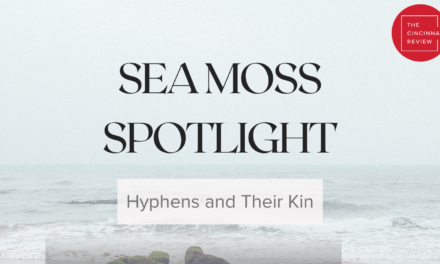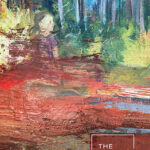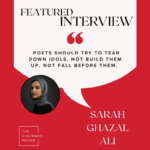
Assistant Editor Lily Davenport: We’ve recently finished our proofreading season at the CR, which means we’ve all been spending a lot of quality time with our style guide, The Chicago Manual of Style (CMOS)—often and affectionately pronounced like this column’s title. While our managing editor, Lisa Ampleman, handles the copyediting (i.e., the heavy-duty editorial work that happens prior to an issue’s being typeset), we still have plenty of occasion to pull out the Manual during the cleanup that follows once proofs arrive. This is one of my favorite parts of working at the CR; I love the Manual, which is huge and unruly and possessed of a dry, understated sense of humor, and I admire its quixotic ambition to encompass every possible use case in written academic English. And, on the flip side, CMOS is also a useful entry point for thinking about the personal and political ramifications of our work as editors—like any “standardizing” text, it was built by human beings with distinct backgrounds, perspectives, privileges, and biases, and some of that baggage inevitably got baked in along the way. I’m excited to highlight my favorite parts of the Manual here, along with the sections that continue to trouble me.
This is also the first installment of this column to cover the latest—eighteenth!—edition of the Manual. The new edition debuted, in print and online, on September 19, with a shiny new color scheme and well over 150 changes significant enough to merit specific attention in the cheat sheet published on the website. (Yes, I looked up the rule for using numbers in dates when only the month and day are provided; it’s still 9.33, “Month and Day,” while the rule for numbering chapters and sections remains 9.28, “Page Numbers, Chapter Numbers, and So Forth.” ) This time around, I’ll be highlighting some of the changes I was most excited to see: more, and more concrete, guidance around inclusive language.
When I heard that the University of Chicago Press was, at last, releasing an updated edition of the Manual, my first thought was something like Please let them address something about more inclusive language practices. I had, at that point, been adjunct-teaching sections of a manuscript-editing course online for several years, and I could never make it through the materials for the weeks we covered chapter 5 and chapter 8 without veering off-script to direct the students to supplemental resources such as the Stonewall Columbus neopronoun conjugation table, the Radical Copyeditor, or the Conscious Style Guide.
Among other things, the seventeenth edition lowercased “indigenous” (8.38) and recommended against the generic use of the singular “they” as a substitute for “he”, though it begrudgingly permitted the use of they/them pronouns (“in general, a person’s stated preference for a specific pronoun should be respected” (5.48) [italics mine]). Additionally, there existed a suite of rules (5.251–5.260) dedicated to “Bias-Free Language”; while the spirit was admirable, the execution focused on creating a balance between two binary-gendered options (or simply on laying out a series of gymnastic verbal tools for not defaulting to a generic “he”), and set aside all other issues related to inclusive language with an admonishment to refrain from using “slighting allusions or stereotypes” and to “avoid language that reasonable readers might find offensive or distracting” (5.253).
More problematic, to my mind, was the barely implicit supposition that anyone would be capable of attaining a completely “bias-free” editorial approach. Assuming that one’s own position is fundamentally neutral is a mental trap of the privileged, and an attitude that, as such, I will always have to remain vigilant about in my own work. Its presence in chapter 5 spoke, to my mind at least, to the level of privilege on the team involved in the Manual’s construction.
I am pleased to report that the current edition of the Manual addresses this larger-scale issue directly, along with many of the individual gaps I had observed in the previous edition. The final heading in chapter 5 now reads “Inclusive Language and Minimizing Bias,” and begins with a brief section, “Making Conscious Choices,” that describes “eliminating all bias from a piece of writing” as “an unrealistic goal” (5.255). (Alas, the end of the sentence states that attending to inclusive language practices “offers important benefits to both writer and readers,” which sounds more like a listicle recommendation for vitamins or a new workout routine than a style-manual entry—but, still, I’ll take it.)
Additionally, section 5.257 acknowledges that the standard for what constitutes both inclusive and offensive or harmful language has changed dramatically over time, and will continue to do so, while new sections discuss ableism in common expressions and euphemisms (5.262), the fraught nature of choosing person-first versus identity-first language in referring to disability (5.261), and the necessity of researching current usage practices for a variety of identity-related terms (5.259).
I was also gratified to see, in the revamped section on the singular “they,” that the “generally” I chafed at for years has been removed from the Manual’s directive to respect nonbinary people’s pronoun usage (5.266). Another welcome change has occurred in chapter 8, in the section covering appropriate capitalization for “Ethnic, National, and Regional Groups and Associated Adjectives” (8.39): “Indigenous” and “Native” are now listed as capitalized, and—with a little hedging—“Black” is as well. The section concludes with a reminder that, “provided a writer’s capitalization choices reflect conscious decisions, editors should limit any interventions to imposing consistency or, when appropriate, suggesting a more specific term.”
These changes mark a heartening shift. In a cultural moment when there’s so much reactionary pushback to the whole notion of inclusive language and its value, and when DEI programs at many of the academic institutions that rely on the Manual for editorial guidance are under fire, it’s bolstering to see the need for attention to inclusivity enshrined there. Still, there’s a cynical part of me that reads these changes as a neoliberal reskin intended to make people like me (white, cis, able-bodied, middle-class) feel better about ourselves: the equivalent of the lesbian-pride-flag socks I bought two years ago at Target, or an office running a one-day workshop on microaggressions in response to a racist incident in the workplace.
And it’s true that, if I were still teaching those editing classes today, I would continue to recommend outside resources to supplement the Manual on this front; it’s not that the guidance there is outright bad, but it remains necessarily incomplete. Yes, the Manual is a living document, but its life is a slow and sessile one, more on the timescale of a tree or a small coral reef than of a human being—its goal is to provide durable guidelines for responding to the ever-changing nature of language usage, not to track that usage in real time.
CMOS isn’t a dictionary, or a wiki, or a social-media feed, or a conversation between two people; if we look to it to provide the kind of usage information present in those sources, which we need in addition to style parameters to make solid editorial decisions about the language we use to discuss and describe marginalized people and their experiences, it will always fail. As pleased as I am about some of the changes in the eighteenth edition, I’m also treating this update as a reminder that CMOS is just one tool—albeit an extremely important one!—in the editor’s kit. The Manual gives us scaffolding, a framework and a process for making editorial decisions; it’s up to us to stay alert to the gaps, and to keep working to fill them in ourselves.










